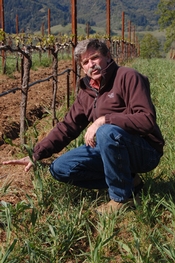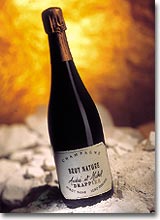WINERY OF THE YEAR
Global warming, carbon footprints, greenhouse gases, higher concentrations of ground level ozone, hotter and longer heat waves, land degradation, habitat destruction–the list of environmental concerns goes on and on. But I’d rather start 2010 in the spirit of hope rather than despair, so while saluting all the winegrowers in the world who are adopting greener viticultural practices I’m selecting the Mendocino Wine Company–one of California’s most innovative, dedicated and eco-friendly wine producers–as my winery of the year.
Mendocino Wine Company was formed in 2004, when Paul Dolan and his partners acquired Parducci Cellars, Mendocino’s oldest winery  (founded in 1932). Dolan, a pioneering producer of premium ecologically oriented wines, first gained attention during his three decades at Fetzer Vineyards, where he was winemaker, then president. Convinced that sustainability is, in his words, “a continuous journey rather than a temporary trend,” Dolan has steered the Mendocino Wine Company in directions that emphasize the health of the land which, in turn, affects the style, structure and flavor of his wines. The number of ways the Mendocino Wine Company has gone green include sourcing grapes from family farms, emphasizing renewable energy by the use of biodiesel vegetable oil-based fuel in their tractors and cars, and using solar power to supply 25% of their energy needs. Parducci, became the nation’s first carbon neutral winery in 2007. The Mendocino Wine Company produces several different labels (all made at the same winery in Mendocino) including Big Yellow, Roselle, and Tusk’n Red. Although I’ve not had the opportunity to taste most of these wines, I am familiar with, and can whole heartedly recommend both the Paul Dolan and the Parducci labels. These are serious and distinctive wines, made with integrity, and reflecting a profound sense of place. They are also surprisingly affordable given the overall high quality of the wines–try the Paul Dolan Chardonnay and Sauvignon Blanc, for example, each $17.99, and Parducci’s Pinot Grigio, Merlot or terrific Petite Sirah, $10.99 each.
(founded in 1932). Dolan, a pioneering producer of premium ecologically oriented wines, first gained attention during his three decades at Fetzer Vineyards, where he was winemaker, then president. Convinced that sustainability is, in his words, “a continuous journey rather than a temporary trend,” Dolan has steered the Mendocino Wine Company in directions that emphasize the health of the land which, in turn, affects the style, structure and flavor of his wines. The number of ways the Mendocino Wine Company has gone green include sourcing grapes from family farms, emphasizing renewable energy by the use of biodiesel vegetable oil-based fuel in their tractors and cars, and using solar power to supply 25% of their energy needs. Parducci, became the nation’s first carbon neutral winery in 2007. The Mendocino Wine Company produces several different labels (all made at the same winery in Mendocino) including Big Yellow, Roselle, and Tusk’n Red. Although I’ve not had the opportunity to taste most of these wines, I am familiar with, and can whole heartedly recommend both the Paul Dolan and the Parducci labels. These are serious and distinctive wines, made with integrity, and reflecting a profound sense of place. They are also surprisingly affordable given the overall high quality of the wines–try the Paul Dolan Chardonnay and Sauvignon Blanc, for example, each $17.99, and Parducci’s Pinot Grigio, Merlot or terrific Petite Sirah, $10.99 each.
WINE OF THE YEAR
Continuing in the spirit of hope (not to be confused with optimism) for the planet, I’m singling out Drappier Brut Nature as my wine of the year. You’ll find the Drappier Champagne house far off the beaten track, in the Aube southern section of the Champagne region, almost on the Burgundy border. The Drappier family has had its roots in Champagne cultivation here since the 17th century. The prestige vintages are housed in magnificent 12th century vaulted cellars once owned by the Cistercian monks (this is one of the only medieval Champagne cellars still left). Fifty-one year old Michel Drappier, who heads the company today, is both heir to one of the most traditional wine estates in the world, and one of the most innovative vintners around. In addition to moving into sustainable agriculture in the vineyards, he has instituted new procedures in the winery, including reducing the amount of sulfur used in the winemaking process. Excess sulfur, he believes, can be harmful to the health of both consumers and winery workers, and it can also mute the fullest potential expression of a wine’s natural qualities. “I am fiercely against the excessive use of sulfur. We use less than any Champagne house I know of,” he told me recently. Drappier’s goal is to be the first to release an entirely sulfur-free Champagne. Whether it’s the results of Michel Drappier’s winemaking philosophy, or of the particular Aube terroir, or those ancient chalky cellars–or all of the above–I am crazy about all Drappier Champagnes. The fragrant and intense rosé, for example, is marvelously fragrant and intricate, and the Carte d’Or manages to be  both supple and invigorating. But it is the Brut Nature that I’m singling out here, both for its deliciousness and its uniqueness. Unlike most Champagnes, this one has been given no liqueur d’expedition—the dash of sugared liqueur that traditionally tops off Champagne–and although not everyone will love the stunningly brut results, I am utterly seduced by the juxtaposition of bone dry minerality and emphatic fruitiness. Add to this the wine’s extraordinary vivacity, its tiny zingy bubbles, and its purity of flavors and you might well conclude that this is one of those Champagnes that will set you back hundreds of dollars instead of less than $50. With wine like this in my flute, I’m ready to face 2010. Champagne Drappier NV Brut Nature is $49, the Rosé is also $49, and the Carte d’Or NV is $39.
both supple and invigorating. But it is the Brut Nature that I’m singling out here, both for its deliciousness and its uniqueness. Unlike most Champagnes, this one has been given no liqueur d’expedition—the dash of sugared liqueur that traditionally tops off Champagne–and although not everyone will love the stunningly brut results, I am utterly seduced by the juxtaposition of bone dry minerality and emphatic fruitiness. Add to this the wine’s extraordinary vivacity, its tiny zingy bubbles, and its purity of flavors and you might well conclude that this is one of those Champagnes that will set you back hundreds of dollars instead of less than $50. With wine like this in my flute, I’m ready to face 2010. Champagne Drappier NV Brut Nature is $49, the Rosé is also $49, and the Carte d’Or NV is $39.
7
